ISSN ONLINE(2319-8753)PRINT(2347-6710)
ISSN ONLINE(2319-8753)PRINT(2347-6710)
Dilip Mishra1 and Dr. N. K. Saikhedkar2
|
| Related article at Pubmed, Scholar Google |
Visit for more related articles at International Journal of Innovative Research in Science, Engineering and Technology
Use of renewable source of energy has now become of utmost attention. With Increasing global pollution and subsequent decrement of global reserves of energy supply is a very crucial factor for environmental protection. Energy generation from renewable sources like- sun and utilization of generated one can optimize the global pollution. In this contrast this paper present one of the system utilizing the solar energy to generate hot water for daily purpose and for industrial purpose.Evacuated U- tube solar water heating system is one of the effective methods of solar thermal energy collection systems.Globally, the industries of solar evacuated tube collectors are growing at 15% annually [1]. India accounts for around 1.5% of the total installed capacity and 1% of the sales during 2008. The paper presented is focused on constructional parameters of the evacuated U-tube solar water heating system.
Keywords |
| Energy, Solar Energy, Water heating |
INTRODUCTION |
| Collection, storage and utilization of solar energy by solar water heating by flat plate and evacuated tube is one of the cheapest and effective renewable energy technologies. Throughout the world (table 1) Solar Water Heater installations are witnessing a rapid growth. Globally, the industries of solar collectors are growing at 15% annually [1]. The two large markets of solar water heaters are China and European countries. |
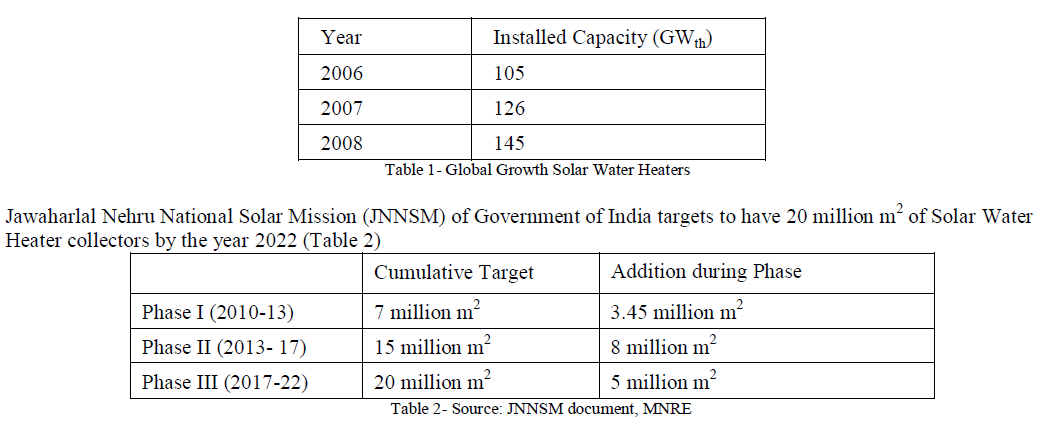 |
| A Solar Water Heating System (SWHS) utilizes the incident solar radiation and convert it in to thermal energy for heating the water to use in various applications [2]. The Solar Water Heating System consists of solar thermal collectors, water tanks, interconnecting pipelines, and the water, which gets circulated within the solar water heating system. Sun rays falling on the collector tube which then heats the tube, thereby transferring the heat energy to water flowing through it. The two popular devices that are used for water heating are Flat Plate Collectors (FPC) and Evacuated Tube Collectors (ETC). Since 2000, the arrival of ETC has had a significant impact on the SWH market. As per MNRE data, in the year 2008-09, ETC constituted more than 30% of the total sales. On July 1, 2009, there were 61 MNRE approved ETC suppliers and manufacturers. The arrival of Evacuated Tube Collector has resulted in expanding the Solar Water Heating supply chain significantly. It has also resulted in reduction in costs of the domestic SWH systems.Morrison et al has [5] reported that evacuated tube solar collectors perform better than flat plate collectors during |
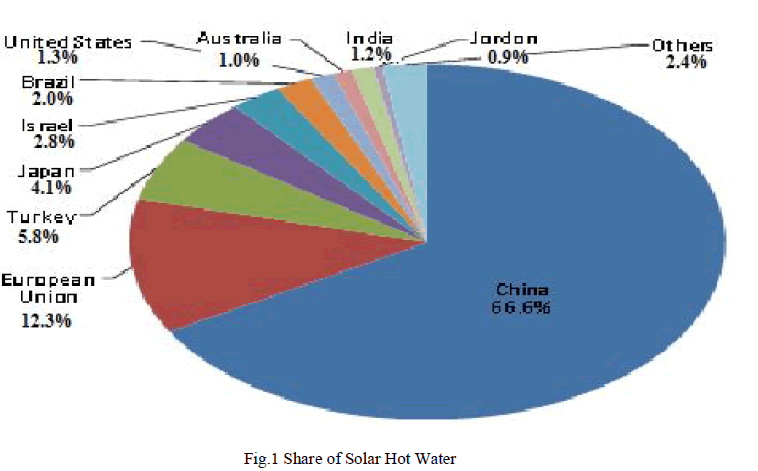 |
| high temperature operations. Nalamwar G. C. et al[12] mentioned that at the same radiation intensity by comparing the heat gain of both the flat plate and vacuum tube solar collector having same capacity tank, mass flow rate and absorber area evacuated tube solar collector gives 16.12% higher efficiency than flat plate solar collector.Brunold S. et al [4] mentioned that evacuated tube solar collector are of three different designs- water-in-glass, heat pipe evacuated tube solar collector, Evacuated U- tube solar collector. Ma L. et al [2] reported that the heat pipe evacuated tubular solar collectors have some advantages, such as anti-freezing, rapid start-up, resistance to high pressure, easy installation and maintenance, etc., many countries have paid more and more attention to them but the heat pipe evacuated tube must maintain the vacuum environment. In the practical application, maintaining vacuum environment is very difficult. Because lots of non-condensable gas will be produced in the heat pipe at the running process of the system. The thermal performance of the heat pipe will be subject to serious influence because of the accumulation of non-condensable gas. So the running life of heat pipe evacuated tubular will be restricted, which is its serious shortcoming. Currently, U-tube glass evacuated tube solar collector is much more widely used compared with the heat pipe. Kim Y. et al experimentally investigated that the U-tube welded inside a circular fin has a best thermal performance among different shapes of absorber tube. The elements for fabrication of evacuated U-tube solar water heating system are presented. |
ELEMENTS OF FABRICATION |
| The main elements required for fabricatingcomplete solar water heating system are- |
| I. Evacuated glass tube, |
| II. Barium getter, |
| III. Copper fin, |
| IV. Copper tube, |
| V. Storage tank, |
| VI. Mounting frame, |
| VII. Insulation, |
| VIII. Manifold |
| All these elements are shown in following figure- |
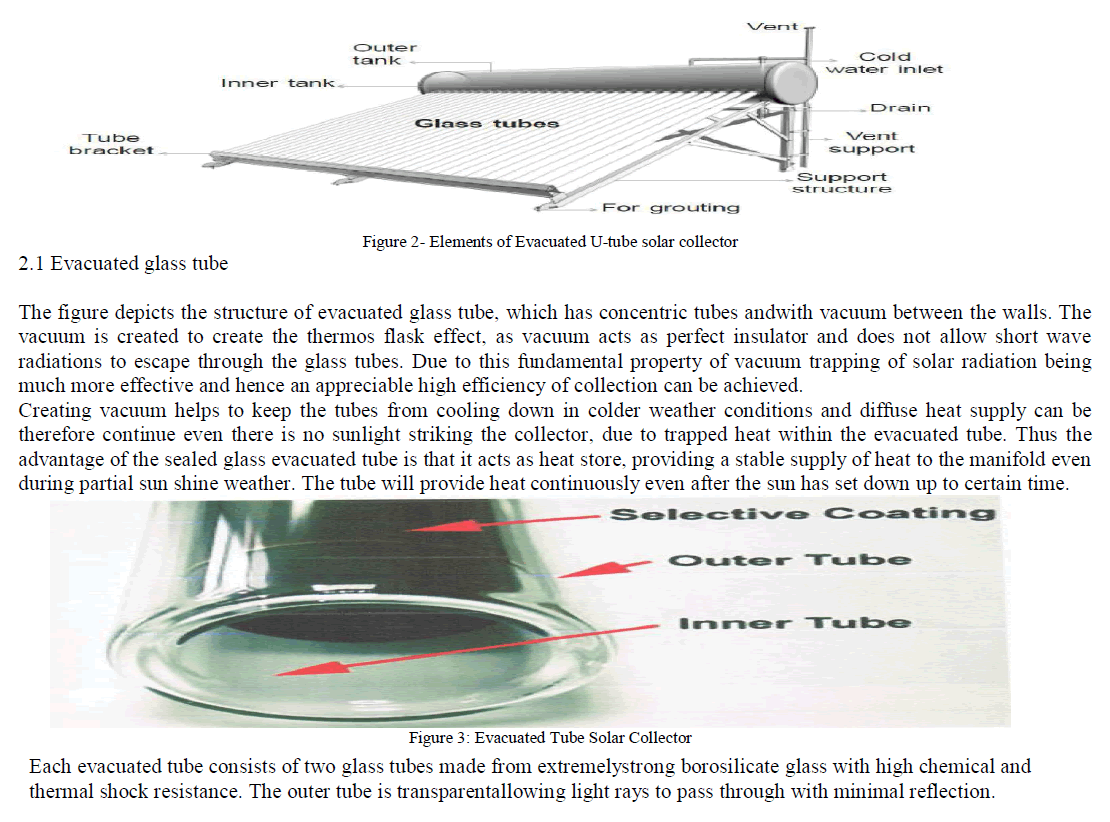 |
 |
| The outer side of the inner tube is coated witha sputtered solar selective coating (Al-N/Al or AlN/AlN-SS/Cu) which features excellent solar radiationabsorption and minimal reflection properties.The top ends of the concentric tubes are fused together and the air present in the annular space of glass is evacuated to eliminate conductive and convective heat losses. |
| Wind and low temperaturehave less of effect on the function of evacuated tubes when compared to flat plate solar collectorsdue to the insulating properties of the vacuum. During the vacuum creation, a Barium Getter is fixed into the base of the outer glass tube. The inner glass tube is then inserted into the outside tube with the Getter centering the inner glass tube. The Glass Tubes now heated to a high temperature simultaneously air is sucked out. The glass tubes are then fused together at the free end. The Barium Getter serves many purpose. One of them is, when the glass tubes are heated before the ends are fused together the Barium Getter also becomes very hot and emits a pure layer of Barium at the bottom of the tube which will look like a chrome plate on the inside of the outer glass tube. |
| If in the future, the glass becomes fractured or broken, the shiny chrome look will change to a milky color, thus, making it easy to check if the vacuum has been lost in a particular glass tube. The barium layer also provides a clear visual indicator of the vacuum status. |
| Barium Getter |
| Barium Getter is used at bottom of the U pipe to create vacuum by pulling out the air and this will reduce the convective heat loss. When this barium getter reacts with air it creates white fumes which will indicate the leakage in the tube. |
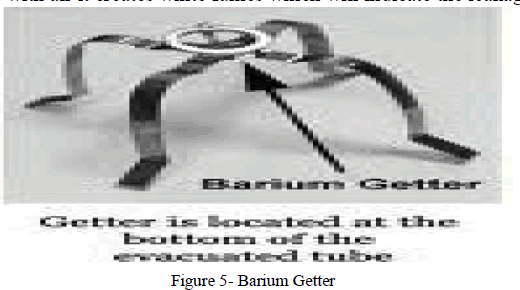 |
| The barium getter also works as indicator of vacuum within the glass tube. This is clearly depicted in following diagram. |
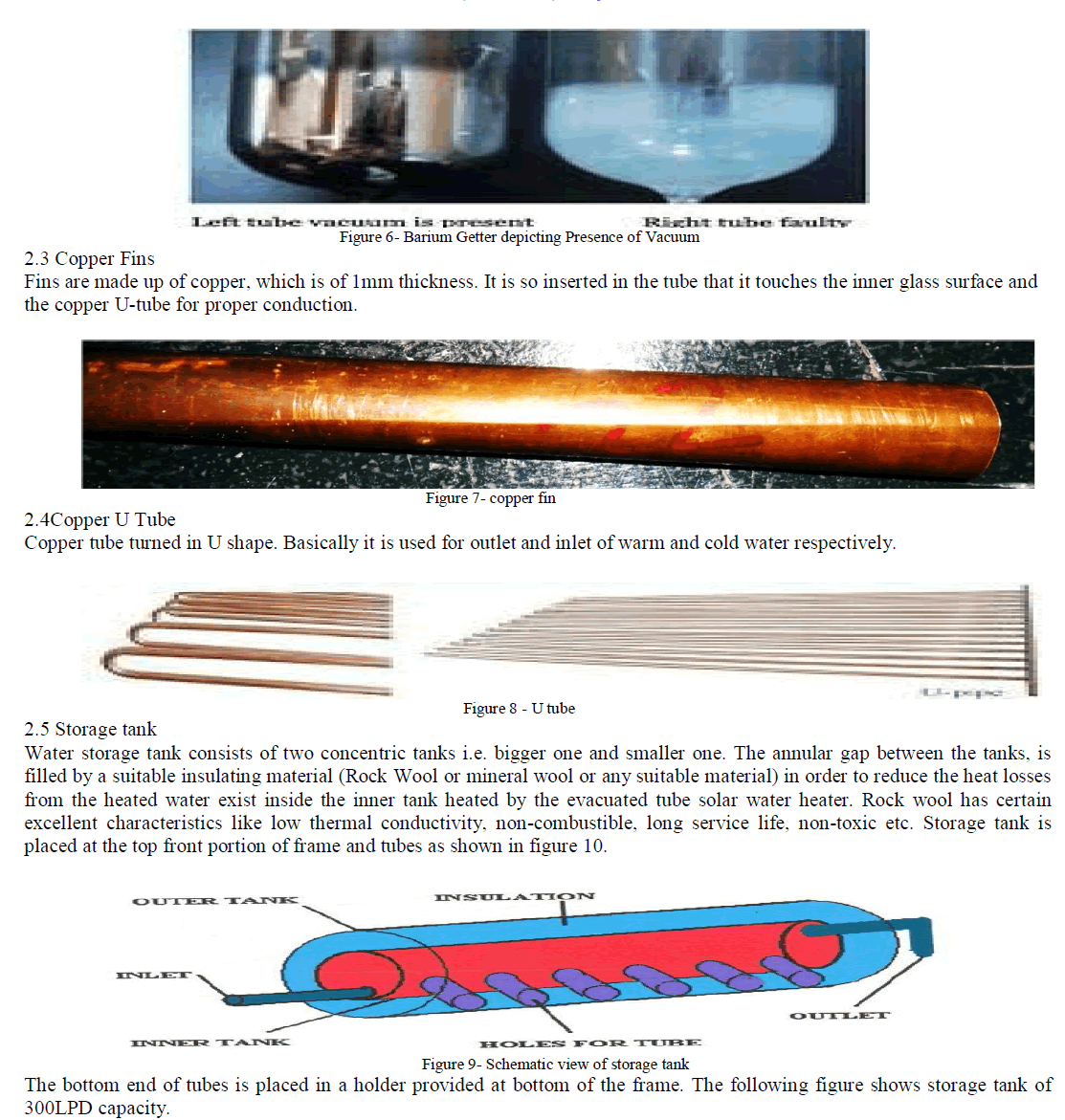 |
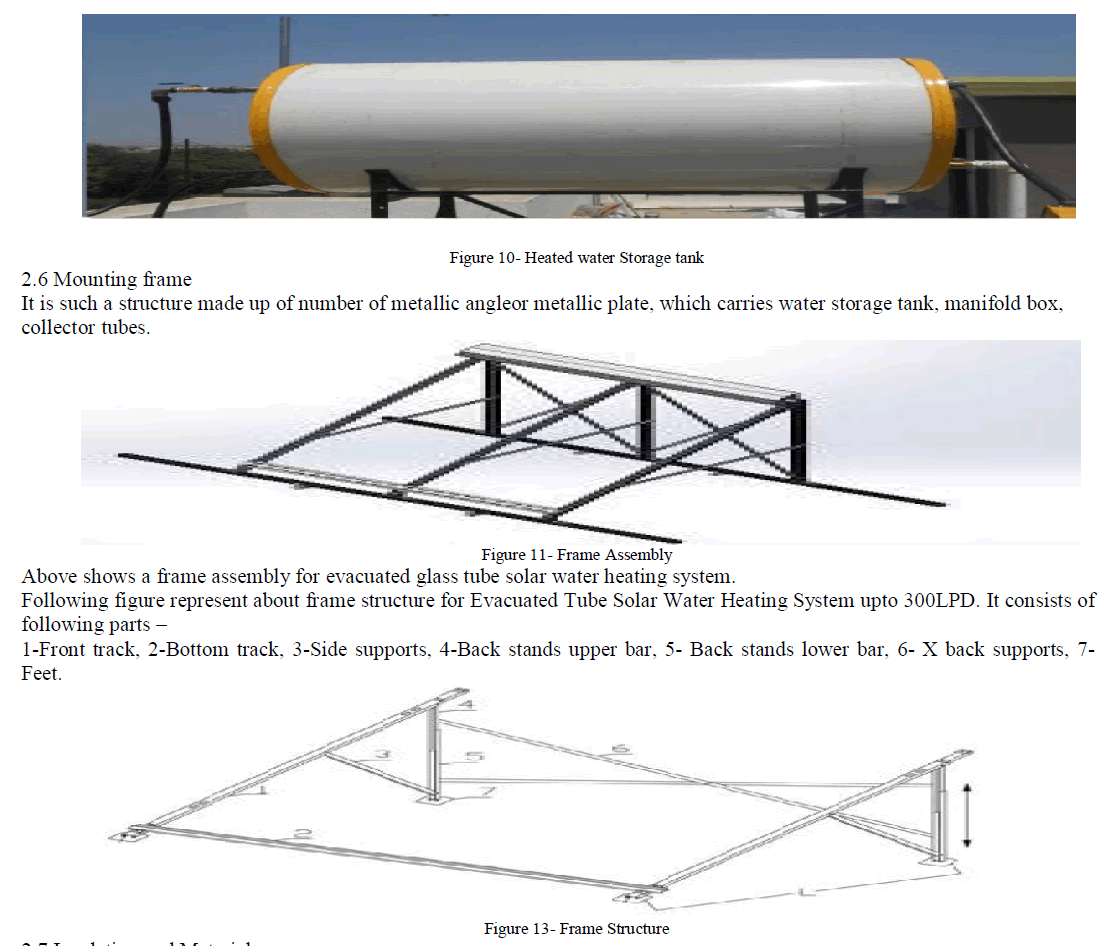 |
| Insulation and Material |
| The word insulationitself defines that the material used to slow the transfer of heat through wallsso as to reduce energy costs and help maintain a uniform temperature. These are materials or devices toinhibit or prevent the conduction of heat or of electricity. Fiberglass, mineral wool, cellulose, foam, polyurethane etc. materials are frequently used as insulation. Thermal insulation is the reduction of the effects of the various processes of heat transfer between objects in thermal contact or in range of radiative influence. Thermal insulation maintains sharp temperature gradient, as it provides a region of insulation in which sharp temperature gradient is maintained at fixed level. Thermal radiation is mostly reflected except a small amount absorption. |
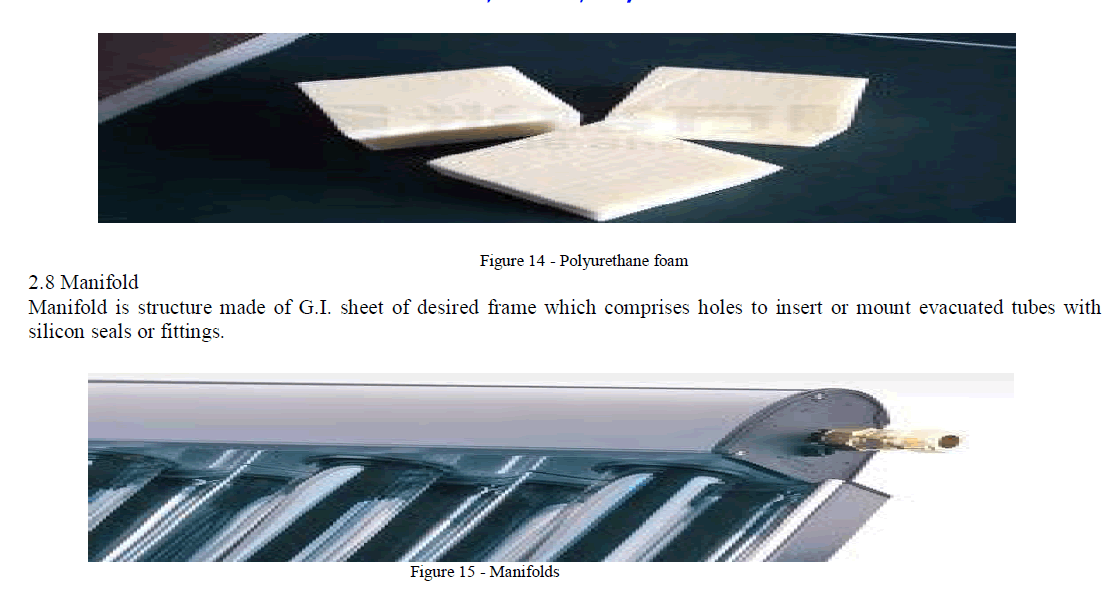 |
WORKING PRINCIPLE OF EVACUATED U-TUBE SOLAR WATER HEATING SYSTEM |
| The working of evacuated solar water heater is based on a natural circulation of water within the system. The Principle is called 'Thermo syphon' the key important point of these systems is that: the evacuated tube solar collector is always tilted a little because straightness of tube would not let flow of water within the tube. |
| As the sun rays pass through outer glass tubes they are largely transmitted directly to the inner glass tubes due to vacuum presence. The inner glass tube outer surface is coated with selective materials. So these sun’s rays are absorbed by the selective coating and gets converted in to heat. As inner tube surface is heated up transfer of heat to the water take place by means of convection inside the inner tubes. |
| The temperature of the water in the tubes rises making it less dense or lighter and hot and lighter water naturally moves up to the top of collector and through the evacuated collectortube goes to the outside and stored. Simultaneously the higher dense water through U tube runs towards bottom. The displacement circuit continues due to density change till the homogeneity in temperature is not achieved. |
MATERIAL SPECIFICATIONOF SOLAR WATER HEATING SYSTEM |
 |
| Borosilicate glass is extremely strong glass due to which small jerk, thermal shock and mechanical vibration cannot harm to the system. The glass tube is transparent. Outer surface of inner glass tube is covered with selective coating generally Al-N selective layer which helps in maximizing the solar radiation absorption. Besides these appreciable properties of glass tube and selective coating, the water carrying tube should also have good thermal conductivity. So the copper metal is selected which has thermal conductivity of 398 w/m.k. |
TECHNICAL SPECIFICATION OF VARIOUS ELEMENTS OF EVACUATED U-TUBE SOLAR COLLECTOR |
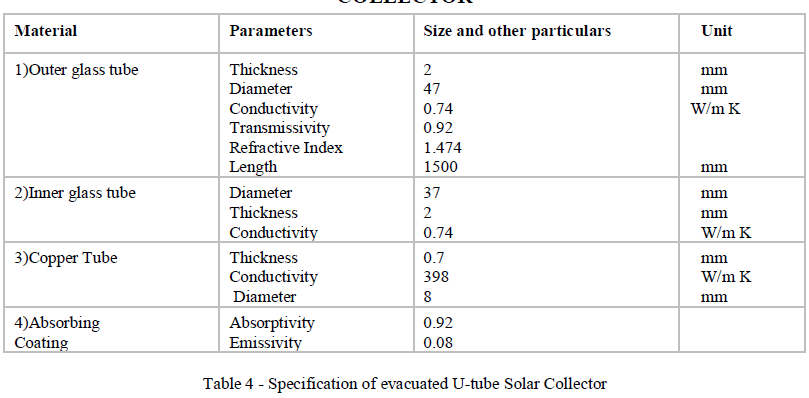 |
| The inner and outer glass tube are made of same material i.e. borosilicate glass of conductivity about 0.74 w/m k. Thickness of tubes are important factor for heat transfer applications. So for good thermal conduction optimum values of thickness has been taken. |
APPLICATION OF EVACUATEDU-TUBE SOLAR COLLECTOR |
| The technology is mainly employed in residential buildings where the demand for hot water is significant. This occurs when there is large family, within laundry washing. Commercial applications include vehicle washing, military laundry facilities and meal facilities. The technology is also employed for heating the space in the winterclimate. Solar water heating systems are most likely to be cost effective for operations such as laundries or kitchens that demands large volume of hot water.Noticeable applications of Evacuated U-Tube Solar collector are as listed below: |
| • In industrial field like energy power plant, steam power plant |
| • In school, hospital. |
| • In laundries, |
| • In space heating |
| • Generally used in northern countries for heating purpose of water like swimming pool as per the season. |
| • It used for domestic purpose like electricity, water heating, and in kitchen stuff. |
RESULTS AND DISCUSSION |
| Using good thermal conductive material results in obtaining better thermal performance. Using vacuum tube technology reduction of various thermal losses is possible. Hence increase in useful heat gain for heating the water is achieved. Further reductions in thermal losses from the water heating system is possible when proper insulation is done of various open parts from where the heat leakage is possible. Also proper insulation of hot water storage tank will prevent heat even when sun light is not present. |
CONCLUSION |
| The experimental and detailed study of the evacuated U-tube solar collector gives the knowledge about a method of reducing certain heat losses from collector. It is found that the evacuated tube solar collector possess 25%-40% more efficiency than flat plat solar collector under same working conditions. A key point noticed that the cylindrical shape of the evacuated tube, the solar tubes are able to absorb heat from all direction i.e. active(direct) radiation and passive(diffuse) solar radiation. Also the cylindrical fin provides better efficiency than any other shape of absorber fin. Evacuated glass tubes are strong, long lasting. Bychance if tube is broken then one can be replaced easily without affecting system performance. |
| Also, future study related to evacuated tube collectors will be to carry out different tests for evaluating performance of evacuated U-tube solar thermal collector and suitability of best collector for the Chhattisgarh climatic condition. |
References |
|